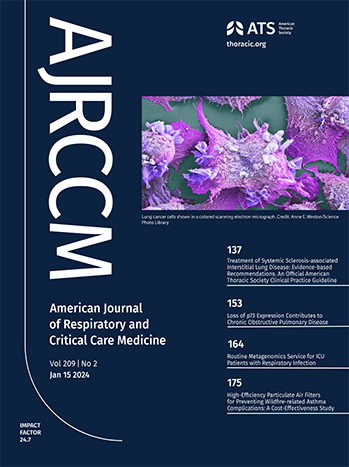Associations of High Attenuation Area-related Proteomic Biomarkers with Fibrotic or Subpleural Interstitial Lung Abnormalities.
IF 19.4
1区 医学
Q1 CRITICAL CARE MEDICINE
American journal of respiratory and critical care medicine
Pub Date : 2025-08-22
DOI:10.1164/rccm.202503-0610oc
引用次数: 0
Abstract
RATIONALE High attenuation area (HAA) is a computed tomography (CT) tool that correlates with lung inflammation and fibrosis. Systemic molecular correlates of HAA (e.g., plasma proteins) may inform biological process involved in interstitial lung disease (ILD). OBJECTIVES Identify plasma proteins that associate with HAA and correlate with a higher probability of developing new-onset fibrotic or subpleural interstitial lung abnormalities (ILA). METHODS Plasma protein levels were measured using a semiquantitative aptamer-based platform in the Multi-Ethnic Study of Atherosclerosis (MESA, n=5486) and Subpopulations and Intermediate Outcome Measures in COPD Study (SPIROMICS, n=1761). Linear regression models identified HAA-associated proteins after adjustment for demographic and socioeconomic factors, CT scanner parameters, study center, and batch. Associations of HAA-related proteins with new-onset fibrotic or subpleural ILA were examined in MESA participants with ILA assessments on full-lung CT 10 years later. Immunohistochemical staining of select proteins was performed in lung tissue from pulmonary fibrosis cases. MEASUREMENTS AND MAIN RESULTS There were 75 proteins detected that were significantly associated with HAA in MESA and SPIROMICS. Gene ontology analysis of these proteins identified processes involved in immune cell chemotaxis and cellular growth and apoptosis. Seven proteins were associated with a higher probability of new-onset fibrotic or subpleural ILA in MESA and two of these, junctional adhesion molecule-like protein and GTP cyclohydrolase 1 feedback regulatory protein, stained in areas of fibrosis in lung tissue from patients with ILD. CONCLUSIONS Plasma proteins associated with more HAA are involved in immune and cellular processes and associate with new onset fibrotic-subpleural ILA.高衰减区域相关蛋白质组学生物标志物与纤维化或胸膜下肺间质异常的关联。
高衰减区(HAA)是一种与肺部炎症和纤维化相关的计算机断层扫描(CT)工具。HAA的系统性分子相关因子(如血浆蛋白)可能为间质性肺疾病(ILD)的生物学过程提供信息。目的:鉴别与HAA相关的血浆蛋白,以及与新发纤维化或胸膜下间质性肺异常(ILA)的高概率相关的血浆蛋白。方法在动脉粥样硬化多种族研究(MESA, n=5486)和COPD研究(SPIROMICS, n=1761)的亚群和中间结果测量中,使用半定量适配体平台测量血浆蛋白水平。在调整人口统计学和社会经济因素、CT扫描仪参数、研究中心和批次后,线性回归模型确定了haa相关蛋白。在MESA参与者中检测haa相关蛋白与新发纤维化或胸膜下ILA的关联,并在10年后通过全肺CT评估ILA。对肺纤维化病例肺组织中选定的蛋白进行免疫组化染色。在MESA和SPIROMICS中检测到75种与HAA显著相关的蛋白。这些蛋白的基因本体论分析确定了参与免疫细胞趋化、细胞生长和凋亡的过程。在MESA中,7种蛋白与新发纤维化或胸膜下ILA的高概率相关,其中两种蛋白,连接粘附分子样蛋白和GTP环水解酶1反馈调节蛋白,在ILD患者肺组织纤维化区域被染色。结论血浆中与更多HAA相关的蛋白参与免疫和细胞过程,并与新发纤维性胸膜下ILA有关。
本文章由计算机程序翻译,如有差异,请以英文原文为准。
求助全文
约1分钟内获得全文
求助全文
来源期刊
CiteScore
27.30
自引率
4.50%
发文量
1313
审稿时长
3-6 weeks
期刊介绍:
The American Journal of Respiratory and Critical Care Medicine focuses on human biology and disease, as well as animal studies that contribute to the understanding of pathophysiology and treatment of diseases that affect the respiratory system and critically ill patients. Papers that are solely or predominantly based in cell and molecular biology are published in the companion journal, the American Journal of Respiratory Cell and Molecular Biology. The Journal also seeks to publish clinical trials and outstanding review articles on areas of interest in several forms. The State-of-the-Art review is a treatise usually covering a broad field that brings bench research to the bedside. Shorter reviews are published as Critical Care Perspectives or Pulmonary Perspectives. These are generally focused on a more limited area and advance a concerted opinion about care for a specific process. Concise Clinical Reviews provide an evidence-based synthesis of the literature pertaining to topics of fundamental importance to the practice of pulmonary, critical care, and sleep medicine. Images providing advances or unusual contributions to the field are published as Images in Pulmonary, Critical Care, Sleep Medicine and the Sciences.
A recent trend and future direction of the Journal has been to include debates of a topical nature on issues of importance in pulmonary and critical care medicine and to the membership of the American Thoracic Society. Other recent changes have included encompassing works from the field of critical care medicine and the extension of the editorial governing of journal policy to colleagues outside of the United States of America. The focus and direction of the Journal is to establish an international forum for state-of-the-art respiratory and critical care medicine.

 求助内容:
求助内容: 应助结果提醒方式:
应助结果提醒方式:


